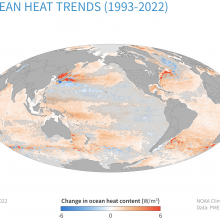International State of the Climate report confirms record-high greenhouse gases, global sea level, and ocean heat in 2022
Ballinger, T.J., J.E. Overland, M. Wang, J.E. Walsh, B. Brettschneider, R.L. Thoman, U.S. Bhatt, E. Hanna, I. Hanssen-Bauer, and S.-J. Kim (2023): Surface air temperature, in State of the Climate in 2022, The Arctic. Bull. Am. Meteorol. Soc., 104(9), S279–S281, doi: 10.1175/10.1175/BAMS-D-23-0079.1, View online at AMS (external link).
Benestad, R., R.L. Thoman, Jr., J.L. Cohen, J.E. Overland, E. Hanna, G.W.K. Moore, M. Rantanen, G.N. Petersen, and M. Webster (2023): 2022 extreme weather and climate events [Sidebar 5.1] , in State of the Climate in 2022. Bull. Am. Meteorol. Soc., 104(9), S285–S287, doi: 10.1175/10.1175/BAMS-D-23-0079.1, View online at AMS (external link).
Johnson, G.C., and R. Lumpkin (2023): Overview. In State of the Climate in 2022, Global Oceans. Bull. Am. Meteorol. Soc., 104(9), S152–S153, doi: 10.1175/BAMS-D-23-0076.2, View online at AMS (external link).
Johnson, G.C., J.M. Lyman, C. Atkinson, T. Boyer, L. Cheng, J. Gilson, M. Ishii, R. Locarnini, A. Mishonov, S.G. Purkey, J. Reagan, and K. Sato (2023): Ocean heat content. In State of the Climate in 2022, Global Oceans. Bull. Am. Meteorol. Soc., 104(9), S159–S162, doi: 10.1175/BAMS-D-23-0076.2, View online at AMS (external link).
Johnson, G.C., J. Reagan, J.M. Lyman, T. Boyer, C. Schmid, and R. Locarnini (2023): Salinity. In State of the Climate in 2022, Global Oceans. Bull. Am. Meteorol. Soc., 104(9), S163–S167, doi: 10.1175/BAMS-D-23-0076.2, View online at AMS (external link).
McPhaden, M.J. (2023): The 2020-22 Triple Dip La Niña, in State of the Climate in 2022, Global Oceans [Sidebar 3.1]. Bull. Am. Meteorol. Soc., 104(9), S157–S158, doi: 10.1175/BAMS-D-23-0076.2, View online at AMS (external link).
Sharp, J. (2023): Tracking global ocean oxygen content, in State of the Climate in 2022, Global Oceans [Sidebar 3.2]. Bull. Am. Meteorol. Soc., 104(9), S189–S190, doi: 10.1175/BAMS-D-23-0076.2, View online at AMS (external link).
Wanninkhof, R., J.A. Triñanes, P. Landschützer, R.A. Feely, and B.R. Carter (2023): Global ocean carbon cycle. In State of the Climate in 2022, Global Oceans. Bull. Am. Meteorol. Soc., 104(9), S191–S195, doi: 10.1175/BAMS-D-23-0076.2, View online at AMS (external link).
Wen, C., P.W. Stackhouse, J. Garg, P.P. Xie, L. Zhang, and M.F. Cronin (2023): Global ocean heat, freshwater, and momentum fluxes, in State of the Climate in 2022. Bull. Am. Meteorol. Soc., 104(9), S168–S172, doi: 10.1175/BAMS-D-23-0076.2, View online at AMS (external link).
The year 2022 was marked by unusual (though not unprecedented) disruptions in the climate system including a “triple-dip” La Niña nearly continuous from August 2020 through the end of 2022, extraordinar

Change in heat content in the upper 2,300 feet (700 meters) of the ocean from 1993-2022. Between 1993–2022, heat content rose by up to 6 Watts per square meter in parts of the ocean (dark orange). Some areas lost heat (blue), but overall, the ocean gained more heat than it lost. The changes in areas covered with the gray shading were small relative to the range of natural variability. NOAA Climate.gov image, based on data from NCEI.


